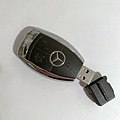USB stick

A USB flash drive (Engl. Stick = bar, floor) generally designates a compact built electronic device that via the Universal Serial Bus (USB) to another device, such as a PC is connected. The USB connector (usually type A) and the housing are directly connected to one another and form a mechanical unit without a connecting cable. In particular, the USB stick is the most common form of the device, the USB memory stick .
The Israeli engineer Dov Moran (* 1956) is considered to be the inventor of the USB stick, which he developed with his company M-Systems . At the end of 2006, M-Systems was sold to SanDisk Corp. for 1.6 billion US dollars . sold.
The miniaturization of USB sticks has been going so far since around 2010 that the original stick can be reduced to a circuit board that can be fully inserted into a USB port. Most devices, however, are either designed a little longer for handling reasons or have the shape of a USB plug with a short handle in order to reduce the risk of loss.
Applications
One of the most common uses of the USB stick is USB memory sticks (“USB sticks” for short), a form of USB mass storage device . These removable media use flash memory to store the data. Small memory card readers are also available, which are often marketed as "adapters" for memory cards or as memory sticks with exchangeable or expandable memory.
Another large area of application are adapters for wireless data exchange. A large number of different protocols and standards are supported here. Above all, there are adapters for connection to a local radio network (" wireless adapter , WLAN stick") or for internet connection via the cellular network (" UMTS stick", see UMTS modem ). In addition, there are adapters for data exchange over short distances via infrared (e.g. IrDA ) or Bluetooth up to simple receivers for wireless mice and keyboards.
Other applications are receivers for digital broadcasting (e.g. DVB-T stick ) and compact devices for data conversion, for example for converting analog video and audio signals. In addition to universal storage devices, there are also devices that only use the built-in data memory internally. These include copy protection plugs ( dongle ), devices for identity and age verification for the protection of minors or security tokens (e.g. SecurID ). There are also data recording devices ( data loggers ) for different physical parameters such as temperature, relative humidity, dew point and GPS-supported devices for logging the location ( GNSS logger ).
Due to the steadily falling price, USB sticks are now also used as advertising media. B. in the form of car keys with promotional videos, technical data and picture galleries of the advertised goods to potential customers as promotional items .
- Different sticks
Web links
Individual evidence
- ↑ Lexicon data protection practice of WEKA MEDIA GmbH & Co.KG Online
- ↑ Guy Grimland: Dov Moran's world of total connectivity. In: Haaretz.com. February 12, 2008, accessed September 26, 2019 .






